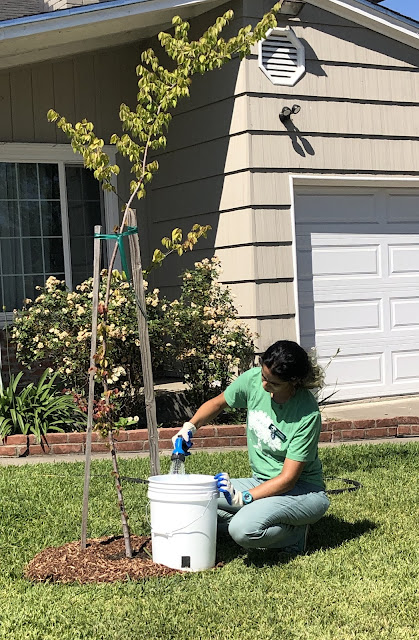
Use a 5-gallon bucket to deep-water where it's needed most

|
|
A 5-gallon bucket with a hole can deliver water
efficiently to a young tree's roots. (Photo courtesy
Sacramento Tree Foundation)
|
Are you worried about your trees during our current drought? Young trees in particular need extra irrigation to make sure they stay healthy and grow strong.
During very dry conditions, young trees of all kinds are most at risk, particularly under 5 years old. These saplings benefit from a slow, deep drink.
According to the Sacramento Tree Foundation, young trees need an extra 10 to 15 gallons of water a week in summer to get established and put down deep roots. The best way to apply this extra irrigation is not with a hose, but a bucket – with a hole in it.
The bucket method – applying water via a 5-gallon bucket – allows water to soak in slowly even in Sacramento’s heavy clay soils. If you just pour 5 gallons of water on the ground next to the tree, it will run off instead of soaking in. With a hose, it’s just a guess how much water you’re applying.
With the bucket, you know exactly how much and where that water will go – down into the tree’s root zone.
SacTree staff experimented and found that a single 1/8-inch hole – located on the bucket’s side about 1 inch above the bottom – was most effective in delivering water at just the right rate. On the bottom, the hole got clogged with dirt. With multiple or bigger holes, the water drained too fast.
How do you use a bucket with a hole in it? Cover the hole with duct tape, fill the bucket, put in place, then remove the tape.
Place the bucket close, within a foot of the trunk, to newly planted trees; their root ball still hasn’t spread out. Alternate sides with each bucket application. As the tree grows, move the bucket farther away from the trunk. The feeder roots that need the extra water most are located along the dripline at the edges of a tree’s canopy.
In the first year, give a young tree an extra 5 gallons two or three times a week, SacTree recommends. In the second year, make it 10 gallons once a week. At three years, increase the extra water allowance to 15 gallons but apply it every other week.
Mulch will help your trees retain that moisture longer. Apply 2 to 4 inches of organic mulch (wood chips, bark, leaves, etc.) out to the tree’s dripline, leaving 6 inches of space around the trunk. Mounding mulch around the trunk allows fungal diseases to attack the tree’s crown.
Mature trees benefit from extra irrigation, too. Instead of a bucket, use a soaker hose encircling the tree at its dripline and set a timer for one hour. Do that once a month.
For more tree tips, visit www.sactree.com .
Comments
0 comments have been posted.Sacramento Digs Gardening to your inbox.
Sites We Like
Garden Checklist for week of May 5
Survey your garden after the May 4 rainstorm. Heavy rain and gusty winds can break the neck of large flowers such as roses. Also:
* Keep an eye on new transplants or seedlings; they could take a pounding from the rain.
* Watch out for powdery mildew. Warmth following moist conditions can cause this fungal disease to “bloom,” too. If you see a leaf that looks like it’s dusted with powdered sugar, snip it off.
* After the storm, start setting out tomato transplants, but wait on the peppers and eggplants (they want warmer nights). Pinch off any flowers on new transplants to make them concentrate on establishing roots instead of setting premature fruit.
* Trim dead flowers but not leaves from spring-flowering bulbs such as daffodils and tulips. Those leaves gather energy to create next year's flowers. Also, give the bulbs a fertilizer boost after bloom.
* Pinch chrysanthemums back to 12 inches for fall flowers. Cut old stems to the ground.
* Mulch around plants to conserve moisture and control weeds.
* From seed, plant beans, beets, cantaloupes, carrots, corn, cucumbers, melons, pumpkins, radishes and squash.
* Plant onion sets.
* In the flower garden, plant seeds for asters, cosmos, celosia, marigolds, salvia, sunflowers and zinnias. Transplant petunias, zinnias, geraniums and other summer bloomers.
* Plant perennials and dahlia tubers for summer bloom.
* Don’t wait; plant summer bulbs, such as gladiolus and tuberous begonias.
* Harvest cabbage, lettuce, peas and green onions.